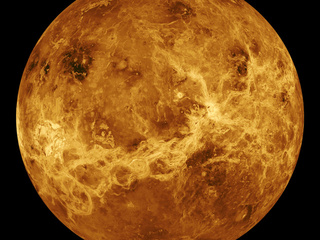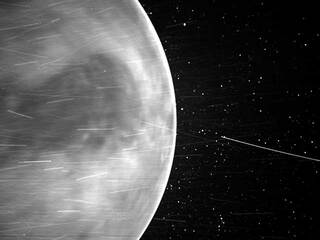When Will Venus Be Visible Again in New England
Overview
Venus is the second planet from the Dominicus and is Earth'southward closest planetary neighbour. It'due south one of the four inner, terrestrial (or rocky) planets, and it's frequently called Earth's twin because information technology's similar in size and density. These are not identical twins, still – there are radical differences betwixt the two worlds.
Venus has a thick, toxic atmosphere filled with carbon dioxide and it'southward perpetually shrouded in thick, yellowish clouds of sulfuric acid that trap rut, causing a runaway greenhouse effect. It's the hottest planet in our solar organization, fifty-fifty though Mercury is closer to the Sun. Surface temperatures on Venus are virtually 900 degrees Fahrenheit (475 degrees Celsius) – hot enough to melt pb. The surface is a rusty colour and it'southward peppered with intensely crunched mountains and thousands of large volcanoes. Scientists think it's possible some volcanoes are still active.
Venus has burdensome air pressure level at its surface – more than xc times that of Earth – similar to the pressure you'd encounter a mile below the ocean on Earth.
Another big difference from Earth – Venus rotates on its axis backward, compared to nigh of the other planets in the solar organization. This means that, on Venus, the Sun rises in the westward and sets in the east, reverse to what we feel on Earth. (It's not the only planet in our solar organization with such an oddball rotation – Uranus spins on its side.)
Venus was the first planet to be explored by a spacecraft – NASA'due south Mariner 2 successfully flew by and scanned the cloud-covered world on Dec. fourteen, 1962. Since then, numerous spacecraft from the U.Due south. and other space agencies accept explored Venus, including NASA's Magellan, which mapped the planet'due south surface with radar. Soviet spacecraft made the virtually successful landings on the surface of Venus to date, but they didn't survive long due to the extreme heat and crushing pressure level. An American probe, one of NASA'due south Pioneer Venus Multiprobes, survived for well-nigh an hour after impacting the surface in 1978.
More contempo Venus missions include ESA's Venus Limited (which orbited from 2006 until 2016) and Nihon's Akatsuki Venus Climate Orbiter (orbiting since 2016).
NASA's Parker Solar Probe has fabricated multiple flybys of Venus. On Feb. 9, 2022, NASA announced the spacecraft had captured its first visible light images of the surface of Venus from space during its Feb 2021 flyby.
In June 2021, 3 new missions to Venus were announced. NASA announced two new missions, and ESA announced one:
- VERITAS: NASA'due south VERITAS, or Venus Emissivity, Radio Science, InSAR, Topography, and Spectroscopy, will be the showtime NASA spacecraft to explore Venus since the 1990s. The spacecraft will launch no earlier than December 2027. It will orbit Venus, gathering data to reveal how the paths of Venus and Globe diverged, and how Venus lost its potential to exist a habitable world.
- DAVINCI: NASA's DAVINCI mission will launch in the late 2020s. After exploring the top of Venus's atmosphere, DAVINCI will drop a probe to the surface. On its 60 minutes-long descent, the probe will accept thousands of measurements and snap upwards-shut images of the surface. The probe may not survive the landing, merely if it does, information technology could provide several minutes of bonus science.
- EnVision: ESA has selected EnVision to make detailed observations of Venus. As a key partner in the mission, NASA is providing the Constructed Discontinuity Radar, chosen VenSAR, to make high-resolution measurements of the planet'southward surface features.
Explore Venus ›
Ten Things to Know Almost Venus
10 Need-to-Know Things Near Venus
1
Toxic Twin
Venus is often called "Earth's twin" because they're similar in size and structure, only Venus has extreme surface rut and a dense, toxic atmosphere. If the Dominicus were every bit tall as a typical front end door, Earth and Venus would each be about the size of a nickel.
ii
Second Rock
Venus is the 2d closest planet to the Sun, orbiting at a distance of about 67 million miles (108 1000000 kilometers)
3
Long Days, Short Years
Venus rotates very slowly on its axis – one twenty-four hour period on Venus lasts 243 Earth days. The planet orbits the Lord's day faster than Earth, even so, and then ane year on Venus takes just about 225 Earth days, making a Venusian day longer than its twelvemonth!
MESSENGER Bids Cheerio to Venus
iv
Diverse Terrain
Venus has a solid surface covered in dome-like volcanoes, rifts, and mountains, with expansive volcanic plains and vast, ridged plateaus.
5
Youthful Surface
The average surface of Venus is less than a billion years old, and perchance as young as 150 million years one-time – which is relatively young from a geological perspective. This is a major conundrum for scientists – they don't know exactly what happened that fabricated Venus completely resurface itself.
half-dozen
Runaway Greenhouse
Venus' thick atmosphere traps heat creating a runaway greenhouse result – making it the hottest planet in our solar organization with surface temperatures hot plenty to cook atomic number 82. The greenhouse upshot makes Venus roughly 700°F (390°C) hotter than it would be without a greenhouse upshot.
7
Stinky Clouds
Venus is permanently shrouded in thick, toxic clouds of sulfuric acrid that outset at an altitude of 28 to 43 miles (45 to 70 kilometers). The clouds smell like rotten eggs!
viii
Spacecraft Magnet
Venus was the first planet explored by a spacecraft and was intensely studied early in the history of infinite exploration. Venus was also the first planet whose surface was reached by a spacecraft from World. The intense heat ways landers have only survived for a couple of hours.
nine
Life on Venus
Venus is an unlikely place for life every bit we know it, but some scientists conjecture microbes might exist high in the clouds where information technology'south cooler and the pressure is similar to Earth'south surface. Phosphine, a possible indicator of microbial life, has been observed in the clouds.
10
Backward Sunrise
Venus rotates astern on its axis compared to most planets in our solar system. This means the Sun rises in the w and sets in the east, opposite of what we run into on Earth.
Mariner ii: Get-go Spacecraft to Explore Venus
Popular Culture
Pop Civilisation
Because information technology'southward and so bright and piece of cake to see in the sky, Venus has played a role in pop civilisation since ancient times, inspiring writing and song:
It was chosen the most beautiful star in the sky by Homer, author of "The Iliad" and "The Odyssey" – ii of the oldest and most important works in Greek literature.
More recently, Venus became a popular venue for 20th-century science fiction writers, including Edgar Rice Burroughs ("Pirates of Venus," 1934); Arthur C. Clarke ("Before Eden," 1961); and C.Southward. Lewis ("Perelandra," 1943).
Australian author Shirley Hazzard won the 1980 National Book Critics Circle Award for fiction with her book, "The Transit of Venus," nearly two orphaned sisters. American writer John Gray used the planet and its masculine counterpart to explain relationships in his 1992 volume "Men Are From Mars, Women Are From Venus."
A song chosen "Venus" was teen idol Frankie Avalon'south outset No. 1 hit when it topped the Billboard Hot 100 chart in 1959. A decade subsequently, a different song chosen "Venus" by the Dutch rock ring Shocking Blue topped the charts in several countries. In 1986, British popular group Bananarama had a No. 1 hit in the U.S. with their cover of the song.
More recently, Venus has been a backdrop for video games such as Transhuman Space, Battlezone, and Destiny. And in the Disney animated film "The Princess and the Frog," Ray the firefly falls in love with Venus, "the evening star," as he has mistaken it for another firefly.
Child-Friendly Venus
Read More than
Read More
- NASA Planetary Photojournal - Venus
- National Space Science Data Center - Venus
- National Space Science Data Heart Photo Gallery - Venus
Source: https://solarsystem.nasa.gov/planets/venus/overview/



0 Response to "When Will Venus Be Visible Again in New England"
Post a Comment